In 1999, the cold winds flowing on the Himalayan peaks of Kargil brought more than the cold of winter. He was one of the most courageous military bets in South Asian history and a decisive reply to India that changed the way of contemplation work in the subcontinent forever. To understand how Operation Vijay turned into an active context of Operation Sindoor from a defensive trend, first Kargil needs to understand more than just a military battle. It was an important turn that showed India’s strategic weaknesses and flexibility that shaped its future theory.
The Kargil conflict did not begin with an arbitrary aggression; It began with planned strategic deception. Operation Badr, which was planned by General Pervez Musharraf at the end of 1998, was a major mistake in understanding how India could demonstrate both restraint and determination. The plan was amazing in its simplicity: Pakistani Northern Light Infantry Battalion will capture the vacant winter posts along with the Line of Control in the Kargil sector, pretending to be a Kashmiri terrorist. This would give him control of National Highway 1A, the main road connecting Srinagar to Leh.
The time and execution of this bet made it particularly fraudulent. Musharraf started this operation when the Lahore Summit was going on, where Prime Minister Atal Bihari Vajpayee offered peace to Pakistan. He had changed the structure of Pakistan’s army to hold his trusted people in important positions. Operation Badr’s strategy showed that Pakistan could not understand the changing international system. Musharraf thought that nuclear equality would give Pakistan a reliable description that would be effective even during aggression. The idea, that atomic weapons can be used as an effective preventive, proved to be very wrong.
Operation Vijay, launched by India, started on 26 May 1999, was a decisive answer to this struggle. Its strategy was based on a balanced and phased military response, which reflects the maturity of India’s military plan despite limited resources. India deployed two full military divisions under highly inaccessible geographical conditions, of which about thirty thousand soldiers were engaged in direct war. The synergy between the infantry and the artillery, the joint plan and accurate coordination of the target, created a military rhythm that the Pakistani forces could not respond.
The atomic dimension made this struggle more complex. Pakistan’s indirectly threatening to use nuclear weapons – especially by Foreign Secretary Shamshad Ahmed, that Pakistan would use its ‘complete military capabilities’, the first clear atomic sign in the history of South Asia. India answered this danger with restraint and strategic clarity. India remained adamant on its ‘No first use’ policy and made it clear that nuclear weapons could not block the reaction of traditional war.
The international community response, especially from the US and China, also rejected Pakistan’s diplomacy and strengthened India’s diplomatic status. China’s neutrality and the US demand for unconditional withdrawal from Pakistan was an indication that global forces were adopting a more responsible and balanced approach towards this struggle.
The Kargil War was also the first media-provided war for India. After the liberalization of India, the emerging middle class first saw the war in broadcast. This war was not only military might but a moment of renaissance of the national psyche. Captain Vikram Batra’s famous proclamation-“This heart mange peacock” was not only a symbol of war victory, but also an indicator of the newly-elevated confidence that India was displaying in its strategic behavior.
The struggle resulted in a doctrinal change in the Indian Resistance Policy, which reached its peak in 2025 as Operation Sindoor. Lessons derived from Kargil-such as the utility of phased reaction, the need for international validity, the importance of technical superiority, and the imperative of political-monetary coordination, laid the foundation for future military strategies. The accuracy of targeted attacks in Sindoor, minimal collateral damage, and low number of casualties developed after Kargil was proof of technology and strategic thinking. The requirements of that time inspired India towards the development of accurate arms systems and better monitoring capabilities.
Kargil gave another important message that the atomic weapons cannot be guaranteed security in traditional wars. In the security equations of South Asia, this experience inspired India to make its strategic approach more firm and active. The strategic maturity that India showed by Pakistan in response to the policy of pseudo -war, the challenges experienced in Kargil.
Harsh Pandey is a PhD researcher at the International Study Institute of Jawaharlal Nehru University.










